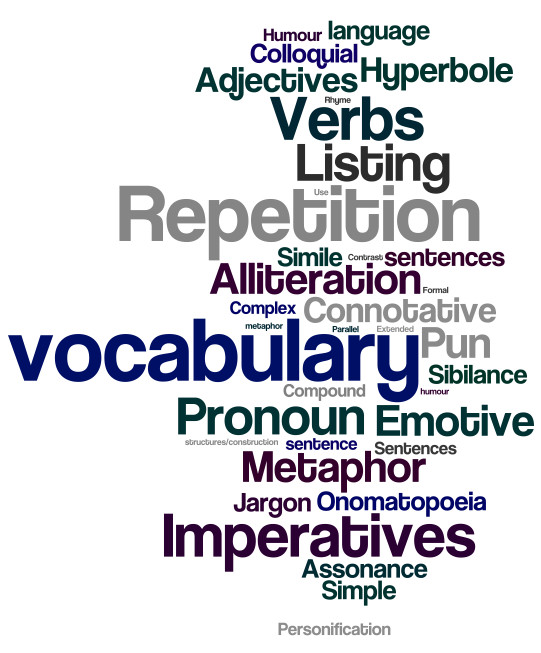Level One Ncea Language Features II

Use the terms you have learnt using the flashcards to identify the examples.
- 1.
KIWITAHI WAY An orchard silvery and green as a sunlit breaking sea. The season stands aside to allow my grandfather his harvest. Over seventy he climbs a ladder and disappears into an apple tree. How they bounce into an empty bucket. Like somebody calling my name out in their sleep over and over Robert Robert What is the name of the language feature used in the first three lines?
- A.
Onomatopoeia
- B.
Assonance
- C.
Personification
- D.
Simile
- E.
Metaphor
Correct Answer
D. SimileExplanation
A simile is a figure of speech that compares two unlike things using the words "like" or "as." In the first three lines of the poem, the orchard is compared to a "sunlit breaking sea" using the word "as." This comparison creates a vivid image of the orchard's appearance, suggesting its shimmering leaves and the movement of branches in the wind.Rate this question:
-
- 2.
KIWITAHI WAYAn orchard silvery and green as a sunlit breaking sea. The season stands aside to allow my grandfather his harvest. Over seventy he climbs a ladder and disappears into an apple tree. How they bounce into an empty bucket. Like somebody calling my name out in their sleep over and over Robert RobertThe season stands aside to allow my grandfather his harvest. What is the name given to this language feature?
- A.
Onomatopoeia
- B.
Assonance
- C.
Personification
- D.
Simile
- E.
Metaphor
Correct Answer
C. PersonificationExplanation
The season is given human qualities-it 'stands aside'Rate this question:
-
- 3.
KIWITAHI WAYAn orchard silvery and green as a sunlit breaking sea. The season stands aside to allow my grandfather his harvest. Over seventy he climbs a ladder and disappears into an apple tree. How they bounce into an empty bucket. Like somebody calling my name out in their sleep over and over Robert RobertThe season stands aside Often a feature can be more than one thing. This is also a sound device. What is the name given to it?
- A.
Assonance
- B.
Onomatopoeia
- C.
Alliteration
- D.
Sibilance
Correct Answer
D. SibilanceExplanation
It is repeating the 's' soundRate this question:
-
- 4.
Like ants in concrete crevices, we work unaware of higher creators.'Concrete crevices' is an example of what sound device?
- A.
Onomatopoeia
- B.
Alliteration
- C.
Assonance
- D.
Sibilance
Correct Answer
B. AlliterationExplanation
The hard 'c' sound is repeatedRate this question:
-
- 5.
Like ants in concrete crevices, we work unaware of higher creatorsWhat is the name given to this kind of comparison?
- A.
Metaphor
- B.
Extended metaphor
- C.
Simile
Correct Answer
C. SimileExplanation
People are compared to ants using 'like'.Rate this question:
-
- 6.
The parched pavement peeled in the hot summer sun.Which term best describes this example?
- A.
Alliteration
- B.
Assonance
- C.
Sibilance
- D.
Onomatopoeia
Correct Answer
A. AlliterationExplanation
The 'p' sound is repeatedRate this question:
-
- 7.
I dunno where we're meeting up tomorrow.Which term best describes this example?
- A.
Slang
- B.
Jargon
- C.
Colloquial language
- D.
Sibilance
Correct Answer
C. Colloquial languageExplanation
'Dunno' is colloquialRate this question:
-
- 8.
There was a big thud when the brick hit the floor.Which term best describes this example?
- A.
Colloquial language
- B.
Alliteration
- C.
Assonance
- D.
Onomatopoeia
Correct Answer
D. OnomatopoeiaExplanation
'Thud' sounds like the word it describesRate this question:
-
- 9.
All you could hear was the buzzing of the fly and then squish! Dad squashed the fly.Which term best describes this example?
- A.
Colloquial language
- B.
Alliteration
- C.
Assonance
- D.
Onomatopoeia
Correct Answer
D. OnomatopoeiaExplanation
'Buzzing' and 'squish' both sound like the words they describeRate this question:
-
- 10.
The dam ran dry during the drought.Which term best describes this example?
- A.
Alliteration
- B.
Assonance
- C.
Sibilance
- D.
Onomatpoeia
Correct Answer
A. AlliterationExplanation
The letter 'd' is repeatedRate this question:
-
- 11.
Nothing Gold Can StayNature's first green is gold, Her hardest hue to hold. Her early leafs a flower; But only so an hour. Then leaf subsides to leaf. So Eden sank to grief, So dawn goes down to day. Nothing gold can stay.Which of the following does not feature in this poem?
- A.
Alliteration
- B.
Personification
- C.
Rhyme
- D.
Simile
Correct Answer
D. SimileExplanation
The poem "Nothing Gold Can Stay" does not feature a simile. A simile is a figure of speech that compares two unlike things using the words "like" or "as." In this poem, there are no direct comparisons using "like" or "as." Instead, the poem uses personification to attribute human qualities to nature, rhyme to create a musical and rhythmic effect, and alliteration to emphasize certain sounds.Rate this question:
-
- 12.
Nothing Gold Can StayNature's first green is gold, Her hardest hue to hold. Her early leafs a flower; But only so an hour. Then leaf subsides to leaf. So Eden sank to grief, So dawn goes down to day. Nothing gold can stay.Which of the following is not an example of alliteration?
- A.
Nothing gold can stay
- B.
So dawn goes down to day
- C.
Her hardest hue to hold
Correct Answer
A. Nothing gold can stayExplanation
'So dawn goes down to day'-repetition of the 'd' sound
'Her hardest hue to hold'-repetition of the soft 'h' soundRate this question:
-
- 13.
The BellsHear the sledges with the bells-Silver bells!What a world of merriment their melody foretells!How they tinkle, tinkle, tinkle,In the icy air of night!While the stars that oversprinkleAll the heavens, seem to twinkleWith a crystalline delight;Keeping time, time, time,In a sort of Runic rhyme,To the tintinnabulation that so musically wellsFrom the bells, bells, bells, bells,Bells, bells, bells-From the jingling and the tinkling of the bellsWhich of the following is not a feature of this poem?
- A.
Simile
- B.
Rhyme
- C.
Onomatopoeia
- D.
Repetition
Correct Answer
A. SimileExplanation
The poem "The Bells" by Edgar Allan Poe does not contain a simile. A simile is a figure of speech that compares two different things using "like" or "as". In this poem, there are various features such as rhyme, onomatopoeia, and repetition, but no explicit comparison using "like" or "as" is made. The poem primarily focuses on the sound and imagery created by the bells, utilizing rhyme, onomatopoeia, and repetition to emphasize the musical quality and the different emotions associated with each type of bell.Rate this question:
-
- 14.
The BellsHear the sledges with the bells-Silver bells!What a world of merriment their melody foretells!How they tinkle, tinkle, tinkle,In the icy air of night!While the stars that oversprinkleAll the heavens, seem to twinkleWith a crystalline delight;Keeping time, time, time,In a sort of Runic rhyme,To the tintinnabulation that so musically wellsFrom the bells, bells, bells, bells,Bells, bells, bells-From the jingling and the tinkling of the bellsWhich of the following is not an example of onomatopoeia?
- A.
How they tinkle, tinkle, tinkle
- B.
From the jingling and the tinkling of the bell
- C.
Hear the sledges with the bells
Correct Answer
C. Hear the sledges with the bellsExplanation
The correct answer is "Hear the sledges with the bells." This is not an example of onomatopoeia because it does not imitate or resemble any sound. Onomatopoeia is a literary device where words mimic the sounds they represent. In contrast, "tinkle, tinkle, tinkle" and "jingling and tinkling of the bells" are examples of onomatopoeia as they imitate the sound of bells ringing.Rate this question:
-
- 15.
A Rose For JanetI know this rose is onlyan ink-and-paper rosebut see how it grows and goeson growingbeneath your eyes:Which term best describes the feature used in the opening lines of this poem?
- A.
Assonance
- B.
Sibilance
- C.
Alliteration
Correct Answer
A. AssonanceExplanation
Repetition of long 'o' soundRate this question:
-
- 16.
'Although I'm not very good, I really enjoy playing football.'What type of sentence is this?
- A.
Compound
- B.
Complex
- C.
Simple
- D.
Imperative
Correct Answer
B. ComplexExplanation
Contains one independent clause and one dependent clause joined by the subordinating conjunction althoughRate this question:
-
- 17.
Please find my yellow leotardWhat kind of sentence is this?
- A.
Compound
- B.
Complex
- C.
Simple
- D.
Imperative
Correct Answer
D. ImperativeExplanation
There is no stated subjectRate this question:
-
- 18.
What language feature is this an example of?
- A.
Pun
- B.
Jargon
- C.
Connotative vocabulary
- D.
Cliche
Correct Answer
A. PunExplanation
It is a play on the word 'down'- in the protesting sense to get rid of and undo in the literal sense.Rate this question:
-
- 19.
The following is excerpt from an article on academic language written by the journalist Robert Fisk. About three years ago, I received a good example of this from Marc Gopin, visiting associate professor of international diplomacy at the Fletcher School of Tufts University and a visiting scholar in the programme on negotiation at Harvard. I received his latest book for review, a tome called Holy War, Holy Peace: How Religion Can Bring Peace to the Middle East. A promising title, you might think. Well, think again.For within pages, I was being bushwhacked by "metaphorical constructs" and "universalist mythic constructs" and "romanticised, amoral constructs of culture" and "fundamental dialogic immediacy" and "prosocial tendencies".Here is another cracker: "The Abrahamic myth of a loving Patriarch and a loving God who care for a special people has created a home and a meaning system for millions of human beings." Come again? Meaning system? The author grew up, he says, "in a self-consciously exilic spirituality".Which term best describes the language described by Fisk?
- A.
Pun
- B.
Jargon
- C.
Connotative vocabulary
- D.
Cliche
Correct Answer
B. JargonExplanation
The language described by Fisk can be best described as jargon. This is evident from the use of complex and specialized terms such as "metaphorical constructs," "universalist mythic constructs," and "fundamental dialogic immediacy." These terms are not commonly used in everyday language and are specific to a particular field or profession, in this case, academic language.Rate this question:
-
- 20.
Another excerpt from an article by Robert Fisk dealing with the use and misuse of language.But it is intended to impress, isn't it? To make us believe that Master Cheetham is clever, nuanced, even – heaven spare us – literate. It is meant to make us believe that he is a Deep Thinker, that Corvus is appealing to the super-educated, those who "push the envelope", who talk the non-language of BBC management and New Labour; it was, after all, not surprising that the BBC's top crap-talk specialist ended up working for Tony Blair.Why is 'push the envelope' in quotation marks?
- A.
To draw the readers attention to it
- B.
To emphasise the idea
- C.
To show that it is not the writers own phrase
Correct Answer
C. To show that it is not the writers own phraseExplanation
The phrase 'push the envelope' is in quotation marks to show that it is not the writer's own phrase. The writer is using the phrase to refer to a specific group of people who use this kind of language, and by putting it in quotation marks, they are indicating that it is a commonly used phrase or expression that they are borrowing or quoting from someone else.Rate this question:
-
- 21.
But it is intended to impress, isn't it? To make us believe that Master Cheetham is clever, nuanced, even – heaven spare us – literate. It is meant to make us believe that he is a Deep Thinker, that Corvus is appealing to the super-educated, those who "push the envelope", who talk the non-language of BBC management and New Labour; it was, after all, not surprising that the BBC's top crap-talk specialist ended up working for Tony Blair.Which term best describes 'push the envelope' in the way that it being used in this article?
- A.
Pun
- B.
Jargon
- C.
Connotative vocabulary
- D.
Cliche
Correct Answer
D. ClicheExplanation
It is an overused expression which has lost its impact and originalityRate this question:
-
- 22.
War On TerrorWhat is the word 'terror' and example of?
- A.
Jargon
- B.
Cliche
- C.
Emotive vocabulary
Correct Answer
C. Emotive vocabularyExplanation
The word 'terror' is designed to appeal to our emotions. It makes us think of fear, danger and horror-it could also be classed as connotative vocabularyRate this question:
-
- 23.
Another Fisk excerptJust look at the individual words we have recently co-opted from the US military. When we Westerners find that "our" enemies – al-Qa'ida, for example, or the Taliban – have set off more bombs and staged more attacks than usual, we call it "a spike in violence".Ah yes, a "spike"! A "spike" is a word first used in this context, according to my files, by a brigadier general in the Baghdad Green Zone in 2004. Yet now we use that phrase, we extemporise on it, we relay it on the air as our phrase, our journalistic invention. We are using, quite literally, an expression created for us by the Pentagon. A spike, of course, goes sharply up then sharply downwards. A "spike in violence" therefore avoids the ominous use of the words "increase in violence" – for an increase, of course, might not go down again afterwards.What aspect of language is Fisk focussing on in this article?
- A.
The connotations of words
- B.
The denotations of words
- C.
Use of jargon
- D.
Use of cliches
Correct Answer
A. The connotations of wordsExplanation
He discusses the ideas associated with the word 'spike' so he is discussing the connotations of this wordRate this question:
-
- 24.
Which of the following is not a connotation associated with the word 'home'?
- A.
A place where someone lives
- B.
A place where someone feels they belong
- C.
A place where someone feels safe
Correct Answer
A. A place where someone livesExplanation
'A place where someone lives' is the denotation. Denotation is the dictionary meaning of a word.
Connotation is the emotional and imaginative association surrounding a wordRate this question:
-
- 25.
Which of the following is not a connotation of the word 'mother'?
- A.
Caring
- B.
Nuturing
- C.
A person who has a child
- D.
Loving
Correct Answer
C. A person who has a childExplanation
A person with a child is the denotation of the word 'mother'. Denotation is the dictionary definition of the word motherRate this question:
-
- 26.
Anthem for Doomed Youth What passing-bells for these who die as cattle? Only the monstrous anger of the guns. Only the stuttering rifles' rapid rattle Can patter out their hasty orisons. No mockeries now for them; no prayers nor bells; Nor any voice of mourning save the choirs, – The shrill, demented choirs of wailing shells; And bugles calling for them from sad shires. What candles may be held to speed them all? Not in the hands of boys but in their eyes Shall shine the holy glimmers of goodbyes. The pallor of girls' brows shall be their pall; Their flowers the tenderness of patient minds, And each slow dusk a drawing-down of blinds. Which of the following is not found in the first four lines?
- A.
Metaphor
- B.
Personification
- C.
Sibilance
- D.
Onomatopoeia
- E.
Alliteration
Correct Answer
C. SibilanceExplanation
Metaphor-'for these who die as cattle' Personification-'monstrous anger of the guns' Onomatopoeia-'stuttering', 'rapid rattle', 'patter' Alliteration-'rifles' rapid rattle 'Rate this question:
-
- 27.
What passing-bells for these who die as cattle? Only the monstrous anger of the guns. Only the stuttering rifles' rapid rattle Can patter out their hasty orisons.'Only the stuttering rifles' rapid rattle' is an example of alliteration. What type of sound does the repetition of the 'r' create?
- A.
Harsh
- B.
Soft
- C.
Slow
- D.
Gentle
Correct Answer
A. HarshExplanation
Certain consonants create a harsh sound e.g. 'r', 'c', 'k', 'q'. Poets use these sounds for effectRate this question:
-
Quiz Review Timeline +
Our quizzes are rigorously reviewed, monitored and continuously updated by our expert board to maintain accuracy, relevance, and timeliness.
-
Current Version
-
Nov 11, 2024Quiz Edited by
ProProfs Editorial Team -
Sep 26, 2010Quiz Created by
Emmabracken77
 Back to top
Back to top





